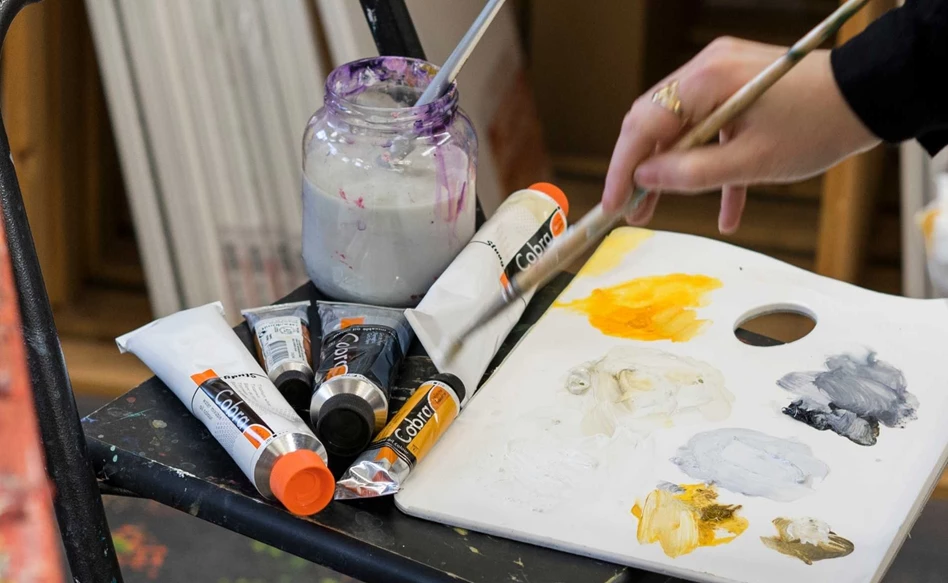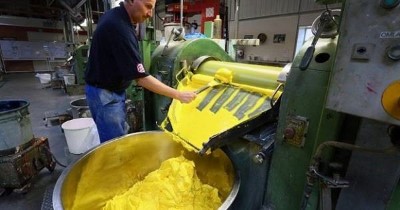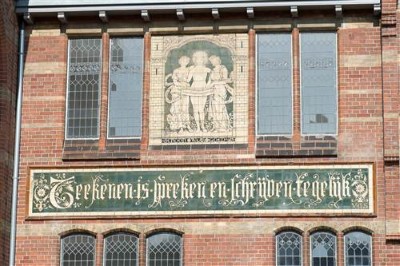
Interview with Irma de Bruijne, Rijksmuseum
“It is a material of today. At a time when the environment and health are very important, we have chosen to use this modern oil paint.”
Interview with Irma de Bruijne from the Rijksmuseum's Teekenschool

photo: Irma de Bruijne
Because we are speaking online, Irma de Bruijne, Head of Studios at the Rijksmuseum's Teekenschool (drawing school), sits at home in her own studio. Through the screen she shows me beautiful works in paint. However, she tends to embroider based on a grid or archetype with very small grains of rice or with vegetable colours. She produced a number of works with three other artists during a stay in India, for which they used the ancient Indian technique of 'block printing'.
Hopefully, I can do that again soon, travel…
What's your educational background?
I graduated from the ArtEZ art academy in Arnhem, having studied in the Architectural Design/Monuments department. I made very large visuals that were always bigger than me!
After graduating, I did a lot of different things and various assignments. I taught children and adults at the 'Wherelant' culture centre, for example. I also became a mother twice and moved from Amsterdam to Beemster. I like being in nature, with the plants and flowers. Nature will always be an important source of inspiration to me.
Eye opener in the Royal Talens paint factory
It was around that time, some 25 years ago, that I first visited Talens. I took a two-day course there and we were shown inside the paint factory. I was completely sold! I had expected to see conveyor belts, which are also great, but that was not the case at all. I saw how the paint was rubbed, what raw materials were used and the tremendous amount of manual work involved. When you see that, you also understand why paint is so costly and why this particular paint is so good. It was a real eye opener.

The Rijksmuseum's Teekenschool
During my course on Didactic Training in the Visual Arts, I did an internship at the Van Gogh Museum. I ended up staying there for 10 years! I also worked as a freelancer at other museums, such as the Stedelijk Museum. A girlfriend of mine then asked: "Wouldn't this job at the Rijksmuseum's Teekenschool be something for you?" It turned out that everyone apart from me had already heard about this job. Fortunately, I got the job because it was made for me and I still enjoy it enormously! The Rijksmuseum wanted to provide more education and they did it in a really big and different way. The Teekenschool always works based on the Rijksmuseum's collection and that's such a wide-ranging collection, you never get tired of it. Every work and every artist has a different technique or something else that is fun to pick apart and do something with.
Actually, Royal Talens does the same thing. They look at what you can do with both traditional and modern techniques. Maybe that's why Royal Talens appeals to me so much, because in a way we are coming from the same place. Because making art starts with the materials. You make the materials and we get the art, and I'm basically a kind of intermediary.

photo: Rijksmuseum
Cobra oil paint in the Teekenschool
Nowadays, artists don't really know how their materials are made and what raw materials are used: they just buy a tube. In the past, it was important that artists knew about their materials. You had to know how the different materials would react to each other. We have lost that knowledge to a certain extent but, on the other hand, people are becoming curious again. They want to find out how materials were used in the past and then imitate the techniques. I notice that at the Teekenschool. We show students how the traditional oil painting technique works but we only use Cobra water-mixable oil paint at the Teekenschool.
We chose Cobra for various reasons:
- The paint contains no solvents. That's much better for everyone's health, especially since many people work indoors and some people may be allergic to solvents such as white spirit.
- It's so nice to see the effect it has, that it's just really good oil paint and that you get amazing results. It's just a fantastic product.
- It is a material of today. At a time when the environment and health are very important, we have chosen to use this modern oil paint.
I wasn't just thinking about myself or the Rijksmuseum. I was being a lot more far-reaching than that, because I believe that this is the oil paint of the future. We're moving with the times!




